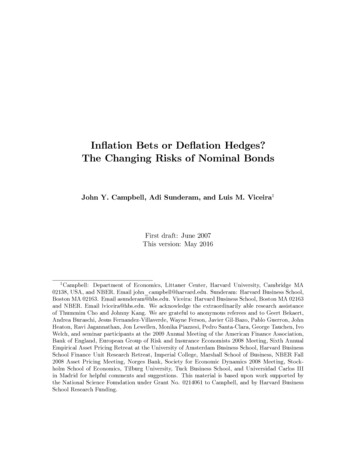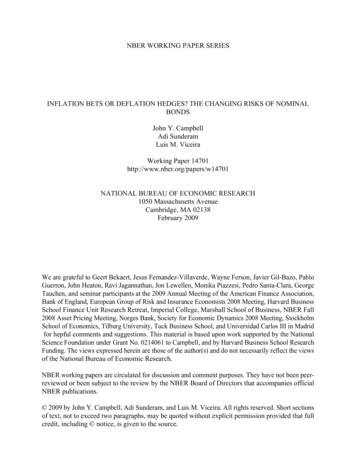
Transcription
In‡ation Bets or De‡ation Hedges?The Changing Risks of Nominal BondsJohn Y. Campbell, Adi Sunderam, and Luis M. Viceira1First draft: June 2007This version: May 20161Campbell: Department of Economics, Littauer Center, Harvard University, Cambridge MA02138, USA, and NBER. Email john campbell@harvard.edu. Sunderam: Harvard Business School,Boston MA 02163. Email asunderam@hbs.edu. Viceira: Harvard Business School, Boston MA 02163and NBER. Email lviceira@hbs.edu. We acknowledge the extraordinarily able research assistanceof Thummim Cho and Johnny Kang. We are grateful to anonymous referees and to Geert Bekaert,Andrea Buraschi, Jesus Fernandez-Villaverde, Wayne Ferson, Javier Gil-Bazo, Pablo Guerron, JohnHeaton, Ravi Jagannathan, Jon Lewellen, Monika Piazzesi, Pedro Santa-Clara, George Tauchen, IvoWelch, and seminar participants at the 2009 Annual Meeting of the American Finance Association,Bank of England, European Group of Risk and Insurance Economists 2008 Meeting, Sixth AnnualEmpirical Asset Pricing Retreat at the University of Amsterdam Business School, Harvard BusinessSchool Finance Unit Research Retreat, Imperial College, Marshall School of Business, NBER Fall2008 Asset Pricing Meeting, Norges Bank, Society for Economic Dynamics 2008 Meeting, Stockholm School of Economics, Tilburg University, Tuck Business School, and Universidad Carlos IIIin Madrid for helpful comments and suggestions. This material is based upon work supported bythe National Science Foundation under Grant No. 0214061 to Campbell, and by Harvard BusinessSchool Research Funding.
AbstractThe covariance between US Treasury bond returns and stock returns has movedconsiderably over time. While it was slightly positive on average in the period 1953–2014, it was unusually high in the early 1980’s and negative in the early 21st Century,particularly in the downturns of 2001 and 2007–09. This paper speci es and estimatesa model in which the nominal term structure of interest rates is driven by four statevariables: the real interest rate, temporary and permanent components of expectedin‡ation, and the nominal-real covariance of in‡ation and the real interest rate withthe real economy. The last of these state variables enables the model to t thechanging covariance of bond and stock returns. In the model, a high nominal-realcovariance implies a high term premium and a concave yield curve. The decline in thiscovariance since the early 1980s has driven down our model-implied term premiumon 10-year zero-coupon nominal Treasury bonds by about 2 percentage points.
1IntroductionIn recent years investors have come to regard US Treasury bonds as hedges, assetsthat perform well when other assets lose value, and more generally when bad macroeconomic news arrives. During both of the two most recent recessions, in 2001and 2007–09, Treasury bonds performed well. In addition, since the turn of thecentury and particularly during these downturns, Treasury bond returns have beennegatively correlated with stock returns at a daily frequency. In previous decades,however, Treasury bonds performed very di erently; they were either uncorrelated orpositively correlated with stock returns. The purpose of this paper is to highlightthese changes in magnitude and switches in sign of the covariation between bondsand stocks, and to ask what they imply for bond risk premia and the shape of theterm structure of interest rates.To understand how a changing bond-stock covariance can a ect the pricing ofTreasury bonds, we specify and estimate a multifactor term structure model thatincorporates traditional macroeconomic in‡uences— real interest rates and expectedin‡ation— along with a state variable driving the variance of real and nominal interestrates and their covariance with the macroeconomy. The model is set up so that allfactors have an economic interpretation, and the covariance of bond returns with themacroeconomy can switch sign. To isolate the e ect of the changing bond-stockcovariance, the model assumes a constant price of risk, or equivalently a constantvariance for the stochastic discount factor. We estimate the model using quarterlyUS time series, beginning in 1953 where possible and ending in 2014, for nominal andin‡ation-indexed bond yields, stock returns, realized and forecast in‡ation, and therealized second moments of bond and stock returns calculated from daily data withineach quarter. The use of realized second moments, unusual in the term structureliterature, forces our model to t the historically observed changes in risks.Our model shows that the risk premia of nominal Treasury bonds should havechanged over the decades because of changes in the covariance between in‡ation andthe real economy. The model predicts positive nominal bond risk premia in the early1980s, when bonds covaried positively with stocks, and negative risk premia in the2000s and particularly during the downturn of 2007–09, when bonds hedged equityrisk. The maximum risk premium we estimate on a 10-year nominal zero-couponTreasury bond is about 1.2% in 1980Q3, and the minimum is about -0.8% in 2008Q3.Thus the model generates a historical spread of about 2 percentage points in bond1
risk premia at this maturity.A second implication of our model is that high bond risk premia are associatedwith a concave term structure of interest rates, speci cally high interest rates at amaturity around 3 years relative to short- and long-term interest rates. In the model,a high bond-stock covariance implies a high volatility of bond returns. The high bondstock covariance generates a high term premium and a steep yield curve at maturitiesof 1-3 years, while the high bond volatility lowers long-term yields through a Jensen’sinequality or convexity e ect. Thus, the concavity of the yield curve is correlatedwith the bond-stock covariance. In this fashion, our model explains the qualitative nding of Cochrane and Piazzesi (2005) that a tent-shaped linear combination offorward rates, with a peak at about 3 years, predicts excess bond returns at allmaturities. However, the model also implies that many other factors a ect the shapeof the yield curve, so the predictability of bond returns from the Cochrane-Piazzesifactor is quite weak in the model. In other words, by incorporating only changes inthe quantity of bond risk and ignoring time-variation in the price of bond risk, ourmodel captures low-frequency variation in term premia associated with the changingbond-stock covariance, but misses some high-frequency variation in term premia.To illustrate the basic observation that motivates this paper, Figure 1 plots thehistory of the realized covariance of 10-year nominal zero-coupon Treasury bonds withthe CRSP value-weighted stock index, calculated using a rolling three-month windowof daily data. For ease of interpretation, the gure also shows the history of therealized beta of Treasury bonds with stocks (the bond-stock covariance divided bythe realized variance of stock returns), as this allows a simple back-of-the-envelopecalculation of the term premium that would be implied by the simple Capital AssetPricing Model (CAPM) given any value for the equity premium. The covariance(plotted on the left vertical scale) and beta (on the right vertical scale) move closelytogether, with the major divergences occurring during periods of low stock returnvolatility in the late 1960s and the mid-1990s.Figure 1 displays a great deal of high-frequency variation in both series, muchof which is attributable to noise in realized second moments. But it also showssubstantial low-frequency movements. The beta of bonds with stocks was close tozero in the mid-1960’s and mid-1970’s, much higher with an average around 0.4 inthe 1980’s, spiked in the mid-1990’s, and declined to negative average values in the2000’s. During the two downturns of 2001 and 2007–09, the average realized betaof Treasury bonds was about -0.2. Thus from peak to trough, the realized beta of2
Treasury bonds has declined by about 0.6 and has changed its sign. According to theCAPM, this would imply that term premia on 10-year zero-coupon Treasuries shouldhave declined by 60% of the equity premium.Nominal bond returns respond both to expected in‡ation and to real interest rates.A natural question is whether the pattern shown in Figure 1 re‡ects a changing covariance of in‡ation with the stock market, or a changing covariance of real interestrates with the stock market. The data suggest that both factors play a role. Toillustrate the importance of in‡ation, Figure 2 plots the covariance and beta of in‡ation shocks with stock returns, using a rolling three-year window of quarterly dataand a rst-order quarterly vector autoregression for in‡ation, stock returns, and thethree-month Treasury bill yield to calculate in‡ation shocks. Because high in‡ationis associated with high bond yields and low bond returns, the gure shows the covariance and beta for realized de‡ation shocks (the negative of in‡ation shocks) whichshould move in the same manner as the bond return covariance and beta reported inFigure 1. Indeed, Figure 2 shows a similar history for the de‡ation covariance as forthe nominal bond covariance.Real interest rates also play a role in changing nominal bond risks. Since longterm Treasury in‡ation-protected securities (TIPS) were rst issued in 1997, TIPShave had a predominantly negative beta with stocks as Campbell, Shiller, and Viceira(2009) emphasize and we illustrate below in Figure 4. Like the nominal bond beta, theTIPS beta was particularly negative in the downturns of 2001 and 2007–09. Thus notonly the stock-market covariances of nominal bond returns, but also the covariancesof two proximate drivers of those returns, in‡ation and real interest rates, change overtime and occasionally switch sign. We design our term structure model to t thesefacts.The organization of the paper is as follows. Section 2 brie‡y reviews the relatedliterature. Section 3 presents our model of the real and nominal term structures ofinterest rates. Section 4 describes our estimation method and presents parameterestimates and historical tted values for the unobservable state variables of the model.Section 5 discusses the implications of the model for the shape of the yield curve andthe movements of risk premia on nominal bonds. Section 6 concludes. An Appendixto this paper available online (Campbell, Sunderam, and Viceira 2016) presents detailsof the model solution and additional empirical results.3
2Literature ReviewDespite the striking movements in the bond-stock covariance illustrated in Figure 1,this second moment has received relatively little attention in the enormous literatureon the term structure of interest rates.2 One reason for this neglect may be thatuntil the last 15 years, the covariance was almost always positive and thus it wasnot apparent that it could switch sign. In the absence of a sign switch, a modelof changing bond market volatility, with a constant correlation or even a constantcovariance between bonds and stocks, might be adequate.The early literature on the term structure of interest rates concentrated on testingthe null hypothesis of constant bond risk premia, also known as the expectationshypothesis of the term structure (Shiller, Campbell, and Schoenholtz 1983, Famaand Bliss 1987, Stambaugh 1988, Campbell and Shiller 1991). Second-generationa ne term structure models such as Cox, Ingersoll, and Ross (1985) modeled changesin bond market volatility and risk premia linked to the short-term interest rate.This approach encounters the di culty that bond market volatility appears to moveindependently of the level of interest rates. In addition, the empirical link betweenbond market volatility and the expected excess bond return is weak, although someauthors such as Campbell (1987) do estimate it to be positive.3In the last ten years a large literature has speci ed and estimated essentiallya ne term structure models (Du ee 2002), in which a changing price of risk cana ect bond market risk premia without any change in the quantity of risk, whilerisk premia are linear functions of bond yields (Dai and Singleton 2002, Sangvinatsosand Wachter 2005, Wachter 2006, Buraschi and Jiltsov 2007, Bekaert, Engstrom, andXing 2009, Bekaert, Engstrom, and Grenadier 2010). Models such as those of Daiand Singleton (2002) and Sangvinatsos and Wachter (2005) achieve a good t tothe historical term structure, but this literature uses latent factors that are hard tointerpret economically.2Exceptions in the last decade include Guidolin and Timmermann (2006), Christiansen andRanaldo (2007), David and Veronesi (2009), Baele, Bekaert, and Inghelbrecht (2010), and Viceira(2012).3More recently, Piazzesi and Schneider (2006) and Rudebusch and Wu (2007) have built a nemodels of the nominal term structure in which a reduction of in‡ation uncertainty drives down therisk premia on nominal bonds towards the lower risk premia on in‡ation-indexed bonds. Similarly,Backus and Wright (2007) argue that declining uncertainty about in‡ation explains the low yieldson nominal Treasury bonds in the mid-2000’s.4
Some papers have extended the essentially a ne approach to model stock andbond prices jointly (d’Addona and Kind 2006, Bekaert, Engstrom, and Grenadier2010). Eraker (2008) and Bansal and Shaliastovich (2013) price both stocks andbonds using the consumption-based long-run risks model of Bansal and Yaron (2004).However, while some of these papers allow the bond-stock covariance to move overtime, none of them allow it to change sign.4In this paper we want to model a time-varying covariance between state variablesand the stochastic discount factor, which can switch sign, and we want out statevariables to be interpretable macroeconomic variables. We take a direct approachand write a linear-quadratic term structure model like those of Beaglehole and Tenney(1991), Constantinides (1992), Ahn, Dittmar and Galla
23.05.2016 · TIPS beta was particularly negative in the downturns of 2001 and 2007Œ09. Thus not only the stock-market covariances of nominal bond returns, but also the covariances of two proximate drivers of those returns, in ation and real interest rates, change over time and occasionally switch sign. We design our term structure model to –t these facts.











